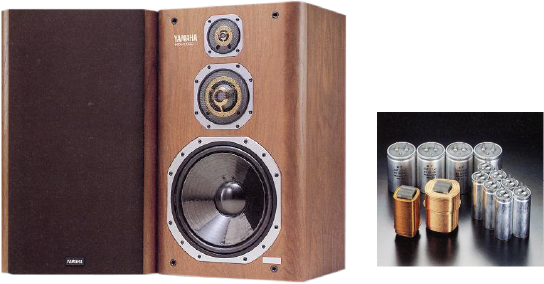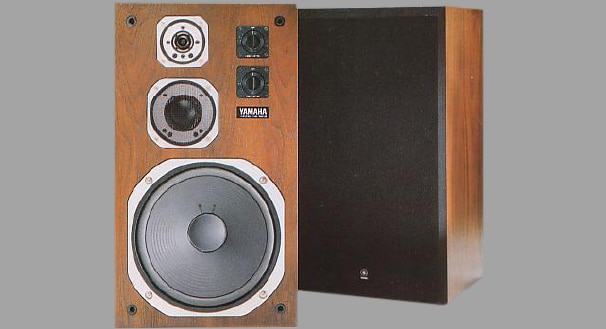NS-5000
NS-5000
Premium Bookshelf-Speaker
2016 debut


History
The dual genealogy of Yamaha Hi-Fi speakers continues in the new NS-5000
The NS-690, equipped with a soft-dome tweeter and midrange, was introduced in 1973, and the NS-1000M, featuring a hard (beryllium) dome tweeter and midrange, in 1974. Although both speaker systems shared the same 30 cm (12") 3-way bookshelf design, each had its distinctive sound characteristics that attracted a following of its own among audiophiles of the time. The question of whether to select a speaker with hard-dome or soft-dome drivers had no definitive answer, as it boiled down to a matter of personal preference for audio and music of each listener. Yamaha’s Hi-Fi speaker systems have since been broadly categorised into two lineages — those using soft-dome drivers and those with hard-dome drivers — from which has emerged the NS-5000, which offers the best of both worlds.
Lineage of Yamaha speakers with soft-dome drivers
Yamaha’s first two soft-dome drivers designed from scratch — the JA-0701 7.5 cm (3") midrange (pictured front right) and the JA-0509 3 cm (1-1/8") tweeter (front left) — found their way into the NS-690. Their naturally extended frequency response and low distortion as well as broad directionality gave the NS-690 the unique characteristics of a natural-sounding speaker capable of delivering excellent resolution of detail and realism. The diaphragm materials originally developed for the NS-690 continued to be refined and used for almost all of Yamaha’s later soft-dome drivers and for edges on the NS-1000M's JA-3058A woofer and many other woofers as well as on the DC diaphragm tweeters (hard dome) found in our speakers released in the 2000s. Meanwhile, the NS-1 Classic introduced in 1988 had, for the first time, a soft dome made of undyed cotton treated with a minimum amount of resin needed to maintain the diaphragm shape, eliminating the need for dual-layer coating of form-stabilising resin and viscoelastic resin.

NS-690 drivers
JA-0509 / JA-0701
Lineage of Yamaha speakers with hard-dome drivers
Yamaha developed the world's first hard-dome drivers with beryllium diaphragms — the JA-0801 8.8 cm (3-1/2") midrange (pictured front right) and the JA-0513 3.3 cm (1-1/4") tweeter (front left). Beryllium, considered as the ideal diaphragm material for its hardness, lightweight (low density), and stiffness, was extremely difficult to be molded into a diaphragm. Yamaha overcame the challenge of processing beryllium with its proprietary electron-beam vacuum vapor deposition method. The overwhelming sense of spaciousness and clarity made possible by the beryllium diaphragms that took advantage of the metal's sound velocity (higher than that of any other practical metal) shattered the perception people had of speakers — so much so that the NS-1000M, the first speaker system to feature beryllium diaphragms, earned wide acclaim from audiophiles and critics worldwide. Later, the NSX-10000 released in 1986 came equipped with GC beryllium diaphragms made of giant beryllium crystals, and the GF-1 introduced in 1991 featured forged beryllium diaphragms. Until the production of all beryllium diaphragms was discontinued in 1997, a hard-dome driver for Yamaha was synonymous with a beryllium-dome driver.

NS-1000M drivers
JA-0513 / JA-0801
Out of the two lineages has emerged the third diaphragm material
After a long and exhaustive search for an ideal diaphragm material to replace pure beryllium, Yamaha has developed a diaphragm made of ZYLON® — a synthetic fabric invented in Japan — and vapor-coated with monel alloy. This combination boasts a sound velocity comparable to that of beryllium yet possesses the characteristic softness of textiles, unveiling the potential of continuing evolution of both soft-dome and hard-dome drivers. Moreover, the NS-5000 uses this material not only for its tweeter and midrange, but also for its woofer, making it possible for the first time to achieve perfect uniformity in tone characteristics among all three drivers.

NS-5000
History of Yamaha speakers with soft-dome and hard-dome drivers
1973 / NS-690

Natural and exquisite “European sound” coming from an unvarnished wood enclosure — the foundation of all subsequent Yamaha Hi-Fi speakers
This 30 cm (12") 3-way bookshelf speaker featured Yamaha’s first soft-dome midrange and tweeter. Its dome drivers had a wide frequency response not commonly found in dome drivers thanks in part to a back cavity added to the midrange, which brought the lowest resonance frequency (f zero) down to 280 Hz. The noteworthy result was the flat mid- and high-frequency response and a smooth transition to the woofer. The NS-690 delivered a natural, nuanced sound with invigorating resonance not typical of Japanese speakers and, combined with its beautiful unvarnished wood enclosure constructed with 3-way mitered joints, was dubbed “European Elegance.” In terms of both technical and design aspects, the NS-690 laid the foundation for all subsequent Yamaha Hi-Fi speakers from the 1970’s and beyond.
1974 / NS-1000M

The world’s first pure beryllium diaphragms in a Yamaha masterpiece, highly acclaimed by audiophiles and sound professionals
The NS-1000M was the world’s first speaker system to have diaphragms made of beryllium of 99.99% purity — previously considered unobtainable — in its midrange and tweeter. The speaker offered the accuracy and clarity of audio reproduction made possible only by beryllium diaphragms that have an excellent transient response, and earned critical acclaim both at home and overseas immediately after it hit the market in 1974. It was adopted as a studio monitor speaker by the Swedish national broadcasting corporation in 1976, and by the Finland national broadcaster in 1978. Even after its successors, the NS-1000X and NS-2000, were introduced, the NS-1000M remained popular and had sold more than 200,000 units over a period of 23 years — before the production of beryllium diaphragms ended and the marketing of the legendary speaker was discontinued in 1997.
1976 / NS-690 Ⅱ

Maintaining the attractiveness and size of the original NS-690, yet refining and upgrading 90% of its elements — making it the “soft-dome version” of the NS-1000M
The NS-690 Ⅱ, which came out in 1976, was an upgraded successor to the best-selling NS-690, with 90% of the original model's elements improved and refined without any change brought to its well-received external appearance or enclosure dimensions. The NS-690 Ⅱ sported the JA-3060 woofer, originally featured in the updated NS-1000M, and used the enclosure materials and construction comparable to those of the NS-1000M, resulting in an increase of 5 kg (11.0 lbs) in weight to 27 kg (59.5 lbs). In addition, the midrange (JA-0701B) and tweeter (JA-0509B) achieved improved linearity thanks to the fully upgraded diaphragm coating and magnetic circuit. In response to the international acclaim that the NS-1000M was enjoying, the NS-690 Ⅱ brought along in many ways the advanced technology and quality components from the 1000M.
1980 / NS-690 Ⅲ

The pinnacle of the NS-690 series, featuring a newly developed cone woofer made of 100% spruce and enclosed in American walnut
Released in 1980, the NS-690 Ⅲ represented the final incarnation of the NS-690 series, which had heralded a golden era for Yamaha Hi-Fi speakers. The most significant feature of this speaker was its cone woofer made of 100% spruce — a diaphragm material made by refining spruce lumber carefully selected as soundboards for Yamaha’s grand pianos. The midrange and tweeter were also upgraded with a newly developed multi-coating agent and a diaphragm integrated with a voice coil bobbin (for the tweeter), bringing its already well-received musicality and linearity to a mature level. The NS-690 Ⅲ came in a different look from its two predecessors: Its external finish was changed from unvarnished wood to American walnut to reflect the speaker design trends of the 1980s.
1982 / NS-2000

New generation beryllium speaker with its key components and enclosure designed from scratch for the coming of the CD age, including a pure-graphite woofer that took full advantage of the characteristics of carbon fibers
The NS-2000, which debuted in the autumn of 1982 in the pre-dawn of the CD age, was — as its name implies — the stepped-up version of the NS-1000 / 1000M; it was also intended to demonstrate how the 1000 / 1000M should evolve eight years after they came out. The most impressive feature of the NS-2000 was the refreshingly deep bass delivered by the 33 cm (13") pure-graphite woofer newly developed using uncut carbon fibers to preserve the integrity of the material. This graphite woofer design turned out to be so successful that it was incorporated into the NS-1000X and NSX-10000 that followed. Moreover, the enclosure was given a modern look with a front baffle that had rounded edges made of solid beech and all drivers placed vertically in line with the centre of the baffle.
1986 / NS-1000X

The "1000" revamped inside and out 12 years after its debut to bring the best out of digital audio sources, sporting a pure-graphite woofer and an enclosure in which all drivers were arranged vertically in line
In 1986, 12 years after the introduction of the NS-1000 / 1000M, the NS-1000X — the latest model in the “1000” series — was released. It looked like a younger sibling of the NS-2000 introduced four years earlier, with its 30 cm (12") pure-graphite woofer, rounded-edged front baffle, and detachable cloth grille, and positioned itself as the heir to the NS-1000 (cosmetically upgraded version finished in ebony gloss lacquer) rather than the NS-1000M. The NS-1000X surpassed the older 1000 / 1000M in overall sound refinement, especially in deep bass reproduction that was a challenge to the original models, demonstrating what 12 years of evolution in speaker technology had yielded. Nevertheless, the refinement that the 1000X brought about shed a renewed light on the distinctive characteristics of the 1000M.
1987 / NSX-10000

Yamaha's top-of-the-line bookshelf speaker system in the 10000-Series of Hi-Fi components, featuring GC beryllium diaphragms that achieved the loss-free transmission of sound waves
The NS-10000 came out in 1987 as part of the 10000-Series top-of-the-line Hi-Fi components commemorating Yamaha’s 100th anniversary. To a casual observer, it looked deceptively like the NS-2000, but actually it was not. In addition to the GC (giant crystal) beryllium developed exclusively for the diaphragms and voice coil bobbins of its midrange and tweeter, other state-of-the-art features that found their way into the NS-10000 included thick brass diffusers attached to the front of the tweeter and midrange, a rounded-edged front baffle made of white birch plywood with a piano-like “bending and kneading” process, a pure-graphite woofer firmly secured to the baffle at 12 points, and a network circuit assembled by plasma spot-welding without using any solder.
1988 / NS-1 classics

Simple-looking yet carefully crafted compact speaker system born out of the back-to-basics philosophy of speaker making, featuring an undyed-cotton soft-dome tweeter and an all-alnico magnetic circuit
The NS-1 Classic had an undyed-cotton soft-dome tweeter, a cone woofer made of polypropylene mixed with undyed mica, and an all-alnico magnetic circuit encased in a galvanised frame. When Yamaha, a renowned specialist in high-tech materials, such as beryllium, carbon fibers, and titanium, released the NS-1 Classic in 1988 at the height of Japan’s economic bubble, it signaled our effort to return to the basics of speaker designing, and to avoid getting dragged into the heated technological competition and an ever-escalating specifications game. This compact speaker, seen as a novelty when it came out, steadily gained popularity over the years, becoming a long-seller of 12 years. Nostalgic yet new, its unmistakably Yamaha sound and styling represents a timeless statement piece.













